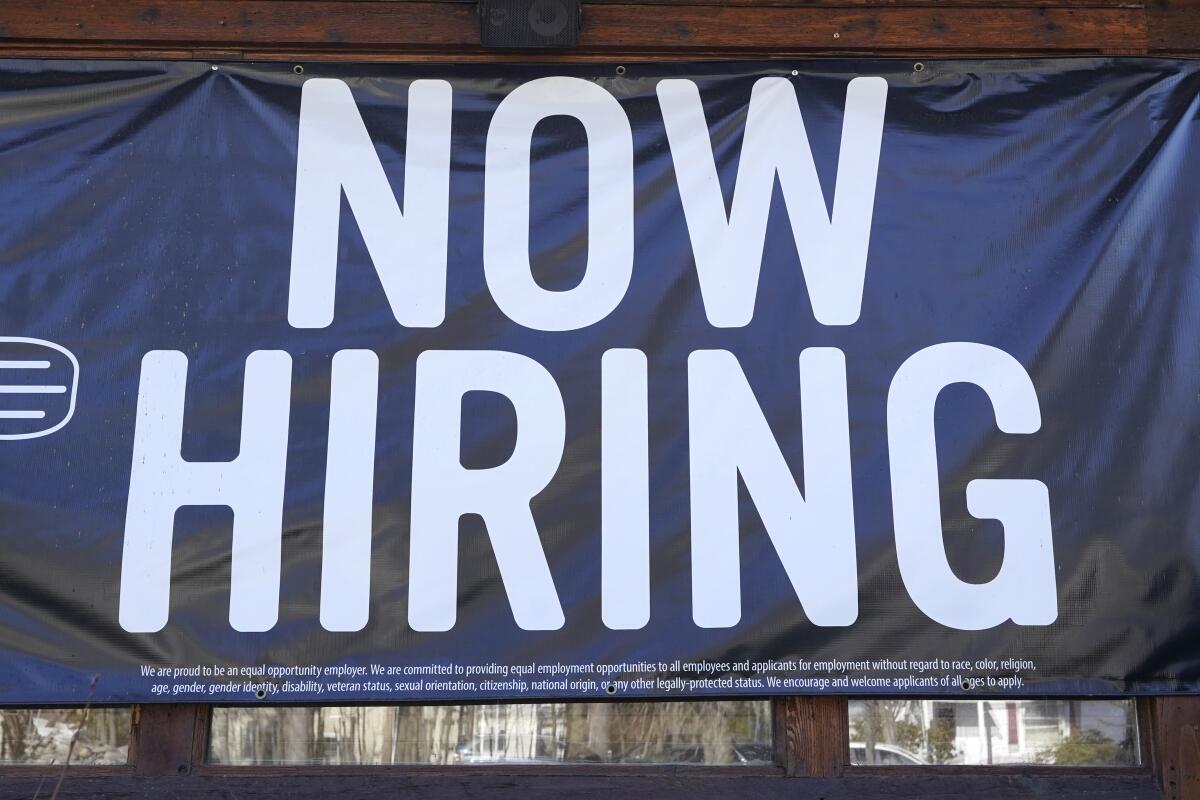Newsletter: Want to switch careers? How to know what you’re qualified to do

Good morning. I’m Rachel Schnalzer, the L.A. Times business section’s audience engagement editor. Burnout has been widespread during the pandemic, and a recent study by Microsoft found that 41% of workers are thinking about leaving their jobs this year.
Some of those workers will pivot to a similar role at a different employer, but others may go for a bigger change.
“Switching careers is not an easy feat,” says Sarah Stoddard, career expert and corporate communications program manager at Glassdoor. “But at the end of the day, when it comes to your career, it’s important to feel satisfied and fulfilled in what you’re doing.”
She and other experts, as well as someone who recently made a substantial career change, spoke with me about how to leverage your abilities and experience to pursue a career that better aligns with your goals.
Figure out what you like and dislike — and what you’re good at
First, make a list of what you like and don’t like about your current job. “Actually write it down,” says Louis Song, co-founder and chief executive of Proven Recruiting, a company that connects employers with job candidates. “One of the biggest problems I think that people have is they kind of just think about it in their head. And it just swirls around, around and around. And they ultimately don’t make any decisions.”
Then identify your strengths in the workplace. “Take an inventory of things that you know about,” career coach Angela Copeland says. This includes skills you’ve picked up outside of work — for example, while volunteering, doing a side project or helping a friend.
Aric Jeon recently made the switch from bioengineering to software development and now works for Microsoft. Why did he pick that field? In part because he figured out that in addition to his aptitude for technology, he enjoys troubleshooting. “I’m not sure if I’m like a masochist or something, but I like solving difficult problems,” he says. That makes his new job a good fit.
Song recommends job seekers try to finish these sentences: “I’m really good at helping companies [insert objective here]” or “I really enjoy helping people [insert objective here].”
Another way to identify where you excel at work, Stoddard suggests: Look at past feedback and performance reviews.
Consider what kind of lifestyle you want
As you determine your professional strengths, also consider your lifestyle goals. You might prefer to live in a single-family suburban home or in an apartment in the city. You might want or need to support children. Perhaps it’s important to you to be able to splurge on big-ticket purchases.
This is a crucial step because it will help determine how much money you’ll need to earn, thus narrowing your career choices.
Start your research
Look into the industries and job functions that interest you. Your local government’s workforce development department is one resource to consult as you explore what’s out there. You can also think about the careers of people you know — friends and relatives, for example, as well as people you may have met through work who interact with your current field but aren’t part of it.
Once you identify a few job functions you think may align with your skills, search for specific openings to determine which skills and qualifications are required for the roles, Stoddard advises. “Doing that research yourself can give you a really healthy gauge on whether that career is something that is available to you right now.”
Keep an eye out for keywords that come up frequently in job descriptions for a particular type of role you want. You can use those words — where applicable — to describe yourself in your resume and cover letter to show hiring managers that your skills are transferable, Stoddard says.
Ask for informational interviews
If you’re curious about a particular career path, you can request a brief informational interview with someone who already works in that field. “Networking is very important when it comes to job searching, but especially when it comes to searching your career,” Stoddard says.
Copeland worked with a job seeker who had experience managing retail stores, and after a few informational interviews with people in different industries, she was surprised to find her retail experience dovetailed well with a career at an advertising agency.
Copeland recommends using informational interviews as an opportunity to build relationships with “loose connections” — people you don’t already know well. “When you start branching out to new people ... that is when you start to overlap into new fields, into new industries, that’s when you learn about things that you hadn’t really thought about before,” Copeland says.
In addition to speaking with your connections and with people working at companies that interest you, Stoddard recommends taking advantage of webinars and other online networking events.
For additional tips, take a look at these pieces about making the most of networking and how to nail a Zoom interview.
Use LinkedIn to your advantage
If you’re hoping to make a career transition, “you have to get a LinkedIn profile,” Song says.
Use your account to convey your goals as a professional, Song advises: “Branding is everything, from the way your profile picture looks, to the banner picture that you use, to the title that you have.” When deciding on a “headline” title to use on LinkedIn, Song advises job seekers to avoid using the title of their current job and instead tailor it to their target career, such as “aspiring product manager.” Tread carefully, though: If you don’t want your current employer to know you’re looking for other work, don’t let the cat out of the bag this way.
You can also indicate your interest and background in the career you’re pursuing by sharing articles, posts and videos related to the subject matter, Song suggests.
Once you have your profile up to date, you can use LinkedIn for extra guidance on your transferable skills. When you explore job opportunities on the platform, LinkedIn will tell you how you compare with other candidates applying for the role, Copeland says. She advises job seekers to keep an eye on the keywords the platform uses to make that comparison. “You can look through and say, ‘Oh, I have that skill. And I didn’t even think to put that on my resume,’” Copeland explains.
Consider a ‘functional resume,’ and always submit a cover letter
Once you’ve identified your transferable skills, highlight them on your resume. “You might want to consider what’s called a functional resume,” Copeland suggests. “Rather than organizing your experience by jobs, it organizes your resume by the functional things that you know about.”
Kent State University’s career center website offers a functional resume template, in addition to more information about this option.
Stoddard recommends using numbers and metrics to quantify the impact you can have in a new job. “If you have a customer service role, you can quantify how many customers you helped every week. Or, if you are in a marketing role ... there are ways to show your impact on engagement metrics,” she explains. “That will help you stand out even more in the eyes of a recruiter and the hiring manager.”
Cover letters are a must, Stoddard says, even when a job application doesn’t require one. “It’s your opportunity to further highlight how your skills transfer into the role that you’re looking for,” she says. “Explain why you’re passionate about the company, passionate about the industry.”
Other stories you may find helpful
◆ Small personal care and retail businesses based in L.A. County — excluding the city of Los Angeles — can apply for $10,000 grants beginning April 26. Note that applicants must have a storefront. Here’s more information.
◆ Can money from Silicon Valley save low-cost housing in South L.A.? Andrew Khouri covers a new program aimed at helping small landlords.
◆ Employers say “lavish” unemployment checks make it hard to hire workers. Don’t believe it, columnist Michael Hiltzik writes.
◆ California is “clawing back” from its pandemic recession. But some 40,000 workers last month gave up on finding a job, Margot Roosevelt reports.
◆ Nonprofit credit counseling can help those dealing with money problems. Certified financial planner Liz Weston offers some insight.
◆ An 800% markup for bloodwork? It’s time to standardize medical test prices, columnist David Lazarus writes.
◆ Less than 1 in 4 workers has gone back to the office — but Roger Vincent reports that employers believe workers will want to return as vaccinations increase.
◆ On that note, how do you feel about going back to work in person? Please let us know.
One more thing
If you’re shopping for a house in popular Los Angeles neighborhoods, prepare to pay way more than the asking price.
The numbers are grim for prospective homebuyers, my colleague Jack Flemming reports: Southern California home prices are at record highs. And within L.A. city limits, more than half of the homes sold last month went for more than the listing price.
“We have lower borrowing rates than we’ve seen in half a century and no inventory. It’s a perfect storm,” Joshua Myler of the Agency, a real estate firm, told Flemming. Read the full story here.
Have a question about work, business or finances during the COVID-19 pandemic, or tips for coping that you’d like to share? Send us an email at [email protected], and we may include it in a future newsletter.
Inside the business of entertainment
The Wide Shot brings you news, analysis and insights on everything from streaming wars to production — and what it all means for the future.
You may occasionally receive promotional content from the Los Angeles Times.




